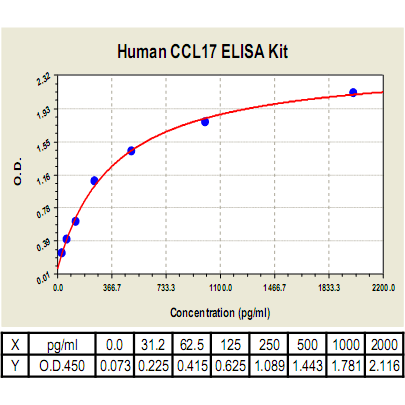Product Sheet CL0684
Description
BACKGROUND Chemokines (Chemotactic Cytokines) are small heparin-binding proteins, which constitute a large family of peptides (60-100 amino acids) structurally related to cytokines whose main function is to regulate cell trafficking. They are subdivided into four families based on the number and spacing of the conserved cysteine residues in the N-terminus of the protein: CXC, CC, CX3C, and C, in agreement with the systematic nomenclature. Chemokines play a major role in selectively recruiting monocytes, neutrophils and lymphocytes as well as inducing chemotaxis through the activation of G-protein-coupled receptors (GPCR).1 Particularly, chemokines and their receptors are essential components of Th1- and Th2-mediated responses. CXCR3 and CCR5 are mainly expressed on Th1 cells whereas CCR3, CCR4, and CCR8 are more characteristic of Th2 cells. These findings demonstrate that chemokines are important in the amplification and polarization of the immune response.
The inducible chemokine CCL17, previously termed thymus and activation-regulated chemokine (TARC) belonging to the CC chemokine family, is strongly upregulated throughToll-like receptor stimulation. CCL17 and the closely related chemokine CCL22 (MDC) bind to the receptor CCR4, which is known to be expressed on activated/memory cells with a Th2 preference, regulatory T cells, Langerhans cells (LCs), basophils, and macrophages. CCL17 and its receptor have been reported to play a role in endotoxic shock, systemic lupus erythematosus, Hodgkin’s lymphoma, and pulmonary fibrosis. CCL17 is expressed constitutively in thymus, but only transiently in phytohemagglutinin-stimulated peripheral blood mononuclear cells.It was shown that CCL17 is specifically expressed by CD8α−CD11b+DEC205+ dendritic cells (DCs). Moreover, CCL17 plays an essential role in the emigration of DCs from the skin to the skin-draining lymph nodes (LNs).2 In addition, it was shown that CCR4 is also highly expressed on both primary malignant cells and leucocytes (tumour-associated macrophages and Treg cells) in these tumour types. Antagonists of CCR4 or CCL17/22 may exert a dual action in these malignancies, inhibiting the pro-tumour immunosuppressive infiltrate as well as having direct effects on cancer cell survival and invasive capacity. Since CCR4 is expressed on only a subset of tumours, there is the potential to select patients expected to be sensitive to CCR4-directed therapies using CCR4 as a companion predictive biomarker.3
The inducible chemokine CCL17, previously termed thymus and activation-regulated chemokine (TARC) belonging to the CC chemokine family, is strongly upregulated throughToll-like receptor stimulation. CCL17 and the closely related chemokine CCL22 (MDC) bind to the receptor CCR4, which is known to be expressed on activated/memory cells with a Th2 preference, regulatory T cells, Langerhans cells (LCs), basophils, and macrophages. CCL17 and its receptor have been reported to play a role in endotoxic shock, systemic lupus erythematosus, Hodgkin’s lymphoma, and pulmonary fibrosis. CCL17 is expressed constitutively in thymus, but only transiently in phytohemagglutinin-stimulated peripheral blood mononuclear cells.It was shown that CCL17 is specifically expressed by CD8α−CD11b+DEC205+ dendritic cells (DCs). Moreover, CCL17 plays an essential role in the emigration of DCs from the skin to the skin-draining lymph nodes (LNs).2 In addition, it was shown that CCR4 is also highly expressed on both primary malignant cells and leucocytes (tumour-associated macrophages and Treg cells) in these tumour types. Antagonists of CCR4 or CCL17/22 may exert a dual action in these malignancies, inhibiting the pro-tumour immunosuppressive infiltrate as well as having direct effects on cancer cell survival and invasive capacity. Since CCR4 is expressed on only a subset of tumours, there is the potential to select patients expected to be sensitive to CCR4-directed therapies using CCR4 as a companion predictive biomarker.3
REFERENCES
1. Gerard, C. & and Rollins, B.J.: Nature Immunol. 2:108-115, 2001
2. Saeki, H. & Tamaki, K.: J. Dermatol. Sci. 43:75-84, 2006
3. Mizukami, Y. et al: Int. J. Cancer 122:2286-93, 2008
2. Saeki, H. & Tamaki, K.: J. Dermatol. Sci. 43:75-84, 2006
3. Mizukami, Y. et al: Int. J. Cancer 122:2286-93, 2008
Products are for research use only. They are not intended for human, animal, or diagnostic applications.
Details
Cat.No.: | CL0684 |
Target Protein Species: | Human |
Range: | 31.2pg/ml-2000pg/ml |
Specificity: | No detectable cross-reactivity with any other cytokine. |
Storage: | Store at 4°C. Use within 6 months. |
ELISA Kits are based on standard sandwich enzyme-linked immunosorbent assay technology. Freshly prepared standards, samples, and solutions are recommended for best results.
Products
| Product | Size | CAT.# | Price | Quantity |
|---|---|---|---|---|
| Human CCLL17/TARC ELISA Kit: Human Chemokine (C-C motif) ligand 17/Thymus and Activation Regulated Chemokine ELISA Kit | Size: 96 Wells | CAT.#: CL0684 | Price: $533.00 |

